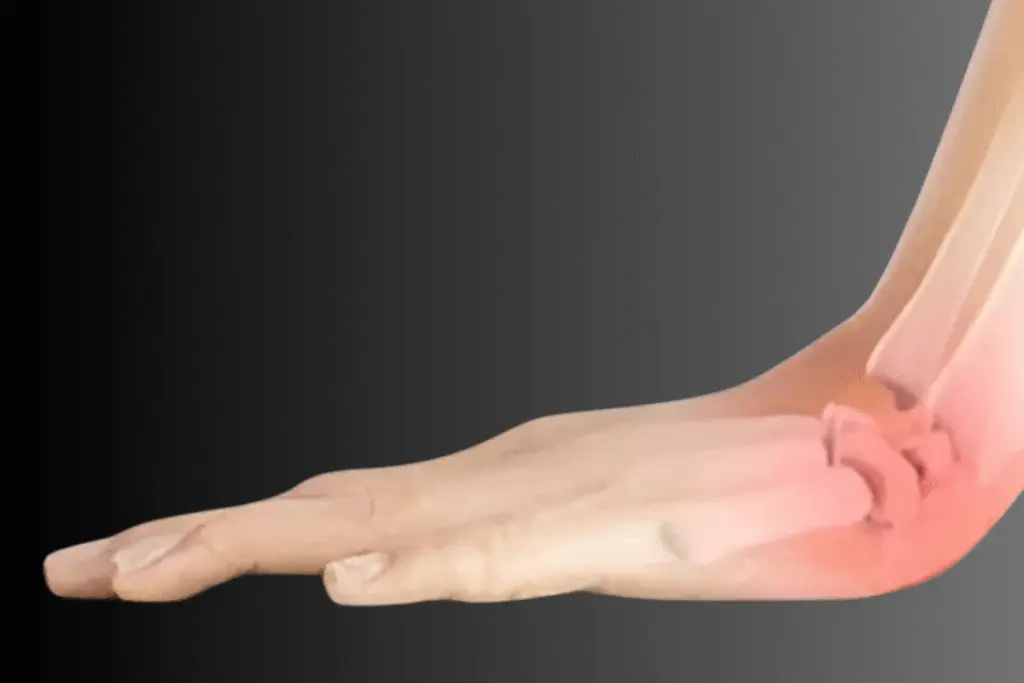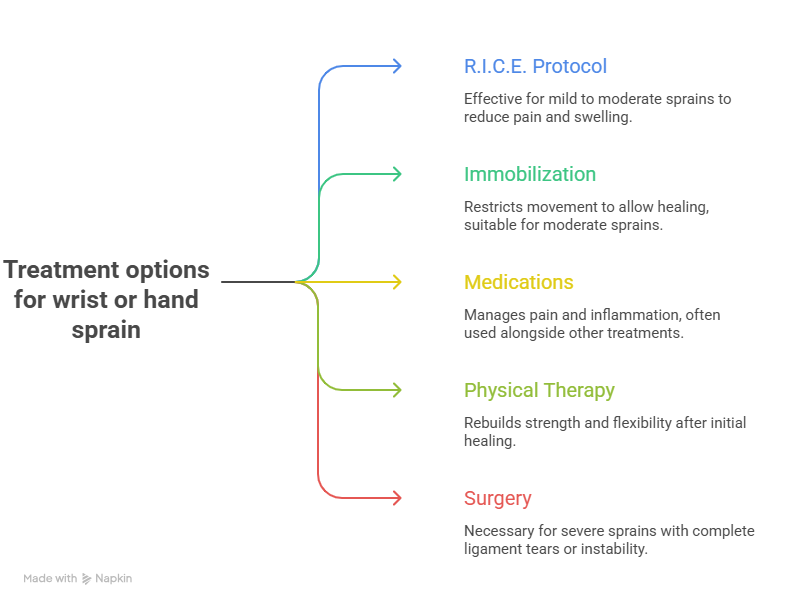- +91 75677 63301
- 24*7 Emergency Care

Wrist and hand sprains are common yet often misunderstood injuries. While they may seem minor at first, untreated sprains can lead to long-term weakness, instability, or chronic pain. Whether you’re an athlete, a desk worker, or someone who recently fell on an outstretched hand, understanding this condition is key to proper care and recovery.
This blog covers everything you need to know about wrist and hand sprains — from symptoms and causes to diagnosis, treatment options (including surgery), and prevention.
Table of Contents
ToggleWhat is a wrist or hand sprain?
A sprain occurs when the ligaments — tough bands of connective tissue that hold bones together — are overstretched or torn. In the hand or wrist, this typically results from trauma or sudden movement that forces the joint beyond its normal range.
The symptoms of a sprain can range from mild to severe, depending on the extent of ligament damage. Common signs include:
- Sudden pain at the time of injury.
- Swelling or puffiness in the wrist/hand.
- Bruising or skin discoloration.
- Difficulty moving the wrist or fingers.
- Tenderness to touch.
- Weak grip strength.
- A popping or tearing sensation when the injury occurred.
Wrist and hand sprains are generally caused by:
- Falling on an outstretched hand (FOOSH injury).
- Sports-related impacts or twists.
- Lifting heavy objects the wrong way.
- Sudden twisting motions.
- Repetitive strain or poor ergonomics (e.g., long typing sessions).
You’re more likely to sprain your wrist or hand if you:
- Play contact or high-impact sports (e.g., football, skating, basketball).
- Have weak ligaments or joints.
- Work in a job with repetitive hand use.
- Have poor posture or lifting techniques.
- Have previously sprained your wrist or hand.
Accurate diagnosis is essential to rule out fractures and ensure proper treatment. Doctors usually perform:
- Physical examination: Checking for swelling, tenderness, and range of motion.
- Medical history: Asking about how the injury happened.
- Imaging tests:
- X-rays: To rule out broken bones.
- MRI or Ultrasound: To assess ligament damage.
- CT scan: In complex or unclear injuries.
Sprains are categorized into three grades based on severity:
- Grade I (Mild): Ligaments are stretched but not torn.
- Grade II (Moderate): Partial tear with swelling and limited motion.
- Grade III (Severe): Complete ligament tear with joint instability.

1. R.I.C.E. protocol
For mild to moderate sprains, start with:
- Rest: Avoid activities that worsen pain.
- Ice: Apply for 15–20 minutes, 2–3 times a day for 48 hours.
- Compression: Use an elastic bandage to reduce swelling.
- Elevation: Keep the hand or wrist elevated to minimize swelling.
2. Immobilization
A splint or brace may be used to restrict movement and allow healing.
3. Medications
Over-the-counter painkillers like ibuprofen or paracetamol can help manage pain and inflammation.
4. Physical therapy
Once initial healing has occurred, guided therapy is crucial to rebuild strength and flexibility in the wrist and hand.
5. Surgery (Rare cases)
While most sprains heal without surgery, Grade III sprains — involving a complete ligament tear or detachment — may require surgical treatment. Surgery is considered when:
- The ligament is completely torn or detached.
- The joint is unstable or misaligned.
- Pain and weakness persist despite conservative treatment.
- The injury affects athletes or people relying heavily on hand function.
- There’s an associated fracture or tendon injury.
Types of surgery:
- Ligament repair: Torn ligaments are reattached to the bone using sutures or anchors.
- Ligament reconstruction: In cases of chronic or severe damage, a tendon graft is used to reconstruct the ligament.
- Arthroscopic surgery: A minimally invasive technique where small tools and a camera are inserted to inspect and repair the damage.
Post-surgical recovery:
- Immobilization: 4–6 weeks with a cast or brace.
- Rehabilitation: Gradual physical therapy to restore motion and strength.
- Full recovery: May take 3 to 6 months, depending on severity and the individual.
Risks:
- Infection
- Nerve damage (rare)
- Persistent stiffness or instability.
- Re-injury if rehab is not followed properly.
Recovery timeline
- Grade I: 1–2 weeks
- Grade II: 3–6 weeks
- Grade III (non-surgical): 6–8+ weeks
- Post-surgical: 3–6 months with rehab
When to see a doctor?
Consult a specialist if:
- Pain or swelling lasts more than a few days.
- There’s visible deformity or bruising.
- You can’t move your hand or wrist properly.
- There’s numbness, tingling, or muscle weakness.
- You’ve had repeated injuries in the same area.
Prevention tips
- Warm up before sports or workouts.
- Use proper form when lifting heavy objects.
- Take regular breaks from repetitive hand activities.
- Wear protective gear during sports or risky tasks.
- Strengthen your wrist and hand muscles with exercises.
- Improve posture and desk ergonomics if you work long hours at a computer.
Conclusion
Wrist and hand sprains may seem minor but can significantly affect your quality of life if left untreated. Early diagnosis, proper care, and consistent rehab are key to a full recovery.
If your wrist or hand pain is not improving, it’s time to seek expert care. At Krisha Hand Hospital in Ahmedabad, we specialize in advanced diagnosis and treatment for all hand and wrist injuries — from simple sprains to complex ligament repairs. Contact us today to book a consultation.
Author bio
Dr. Karn Maheshwari is the founder of Krisha Hand Hospital, Ahmedabad, established in 2016. He is the only fnb-qualified hand surgeon across Gujarat, Rajasthan, and Madhya Pradesh.
With MS and DNB in orthopedics, Dr. Maheshwari specializes in treating a wide range of hand and wrist conditions, including carpal tunnel syndrome, sports hand injuries, orthopedic hand surgery, ganglion cysts, mangled hand injuries, congenital hand differences, brachial plexus palsy, cerebral palsy & spastic hand, hand tendinopathy, hand microsurgery, hand swelling, hand transplants, hand reimplantation, rheumatoid hand deformities, and peripheral nerve injuries & compressive neuropathies.
Dr. Maheshwari’s unmatched expertise and patient-centric approach ensure world-class treatment, advanced surgical solutions, and optimal recovery for patients with complex hand and wrist conditions.
FAQs
A sprain usually causes swelling, pain, and reduced movement, but you can still move the wrist slightly. A break may cause severe pain, visible deformity, inability to move the wrist, and intense swelling. Only an X-ray can confirm the difference.
Mild sprains may heal in 1–2 weeks, moderate ones in 3–6 weeks, and severe sprains (especially those needing surgery) can take 3–6 months for full recovery.
Yes, in most cases you may still have some range of motion with a sprain, but movement will likely be painful. If you cannot move it at all or notice deformity, seek medical attention.
If swelling, pain, or reduced mobility persists beyond a few days — or if there’s bruising, numbness, or instability — you should see a doctor to rule out fractures or ligament tears.
An untreated sprain may lead to chronic pain, joint instability, reduced grip strength, or long-term joint damage. Early diagnosis and treatment are important to prevent complications.
While typing is more associated with repetitive strain injuries like carpal tunnel syndrome, poor wrist ergonomics over time can weaken ligaments and increase the risk of minor sprains or strains.
No, most sprains heal without surgery. Surgery is only needed in rare cases of complete ligament tears (Grade III), instability, or when conservative treatments fail.
Yes. Strengthening wrist and hand muscles, improving posture, using protective gear during physical activity, and maintaining ergonomic work habits can help prevent future sprains.
A sprain affects ligaments (which connect bones), while a strain involves muscles or tendons. Both can cause pain and swelling but affect different tissues.
Mild sprains may improve with rest and self-care, but without proper treatment or immobilization, healing can be incomplete, leading to future instability or pain.
Avoid lifting heavy items, high-impact sports, repetitive typing, or any activity that strains the wrist until fully healed or cleared by a doctor.
Yes, especially if untreated. Chronic instability, reduced grip strength, recurring pain, and arthritis can result from unresolved severe sprains.
Yes. Wrist braces or splints support the joint, reduce movement, and protect the area during healing. However, they should not replace active rehab once recovery begins.
Rehab may include stretching, grip exercises, strength training, and range-of-motion activities guided by a physiotherapist over several weeks or months.
Yes, especially from sports or playground falls. Since their bones and joints are still developing, proper diagnosis and care are crucial to avoid growth-related complications.
